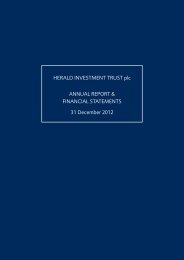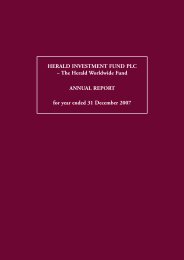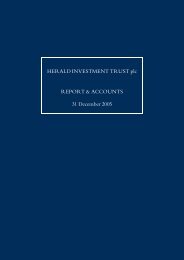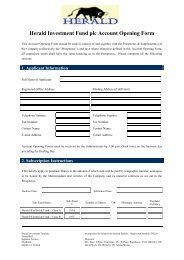HERALD INVESTMENT TRUST plc ANNUAL REPORT ...
HERALD INVESTMENT TRUST plc ANNUAL REPORT ...
HERALD INVESTMENT TRUST plc ANNUAL REPORT ...
Create successful ePaper yourself
Turn your PDF publications into a flip-book with our unique Google optimized e-Paper software.
CHAIRMAN’S STATEMENT<br />
The macroeconomic and stock market background was more benign in 2010. This was reflected in<br />
a continued recovery in the Company’s market value and the net asset value (NAV) per share grew<br />
41.2%, comfortably ahead of any relevant index.<br />
The UK, which still accounts for the majority of the portfolio, had a total return of 42.4%. In<br />
comparison, the FTSE Small Cap index had a total return of 19.9%, and the FTSE 100 of 13.1%. The<br />
US portfolio performed even better with a $ return of 47.5%. This compares with the NASDAQ<br />
rising 18.2% and the Russell 2000 Technology Index rising 37.4%. The exchange rate enhanced<br />
these returns to 52.6% in £. The local currency return in Europe was a more modest 20.9%, 17.8%<br />
in sterling, but the Company’s European exposure is now very modest. The Far East returned 15.6%<br />
in local currencies significantly enhanced by currency (27.5% in £). This lower return is consistent<br />
with the Manager’s cautious weighting; the Taiwanese stock exchange Electronics index and the<br />
KOSDAQ IT index were relatively flat in local currencies.<br />
In spite of the robust growth in NAV per share of 41.2%, the valuation of the portfolio is similar to<br />
last year in p/e terms illustrating the robust underlying growth in profits. This is somewhat higher<br />
than the long term growth rate and reflects a recovery in profits in certain companies that had been<br />
adversely impacted by the recession in 2009 and some of the funds raised through takeovers and<br />
profit taking giving the opportunity to reinvest on lower valuations. Nevertheless it provides an<br />
encouragingly solid base for further growth in 2011.<br />
It is interesting to observe that smaller companies have continued to outperform larger ones in the<br />
technology sector in 2010, and the UK and the US have significantly outperformed the Far East<br />
and Europe, and the wider indices. The portfolio has been well positioned to exploit this. It might<br />
be worth illustrating some long term figures to highlight the long term performance divergences.<br />
Compound annual rate of return from inception and from full globalisation at the end of 1998<br />
21/02/1994 31/12/1998<br />
HIT NAV (fully diluted) 11.2% 9.4%<br />
HIT share price 10.4% 9.6%<br />
HIT UK capital 15.7% 15.1%<br />
HGSC capital 5.5% 7.4%<br />
Russell 2000 Technology £ – 3.4%<br />
Taiwan Electronics £ (total return) – 5.0%<br />
KOSDAQ IT £ (total return) – (0.2%)<br />
Source: HIML<br />
There are a number of interesting points to make. Firstly the Company’s NAV has compounded<br />
in capital terms since inception at 11.2% per annum. The UK (+15.7% per annum) and European<br />
portfolios (+13.9% per annum) which were the Company’s original focus, have compounded<br />
somewhat faster than this. This is significantly ahead of the returns on the UK market as a whole and<br />
the various smaller companies indices and demonstrates that the UK has been, and the Manager<br />
believes will remain, a fertile area for investing in TMT stocks. The satisfactory UK return has also been<br />
enabled by the opportunity to exploit the market’s volatility. In particular the Manager raised cash in<br />
2000 but was a net investor in 2002, 2008 and 2009. Whilst the fund has benefited from its specialist<br />
focus on the sector, which is now unique in the UK, the US portfolio has performed satisfactorily<br />
relative to US indices but lagged the UK. The focus on the US, where trends emerge first, has also<br />
enabled greater returns in the UK. The long term returns have been weaker elsewhere, which in<br />
part reflects a greater focus on the UK and US, but the asset allocation has correctly perceived the<br />
easier returns in the UK. The Taiwanese electronics index has performed marginally better than the<br />
Russell 2000 Technology Index, but the KOSDAQ IT index in Korea much worse.<br />
<strong>HERALD</strong> <strong>INVESTMENT</strong> <strong>TRUST</strong> <strong>plc</strong> 5








